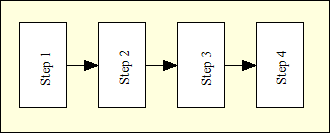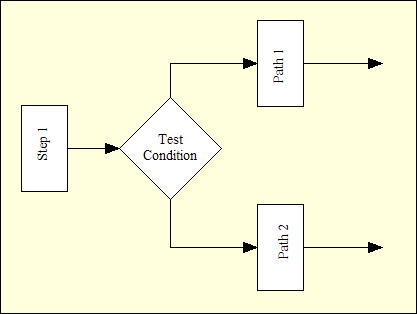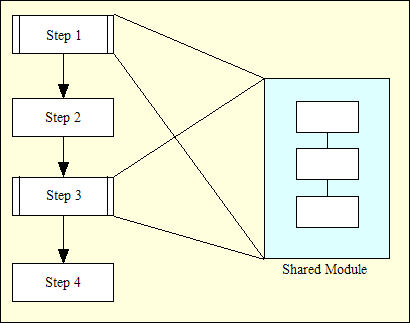What is Programming?
| What will we cover? |
| An introduction to the terminology of computing plus some history
and a brief look at the structure of a computer program.
|
Back to Basics
Computer Programming is the art of making a computer do what
you want it to do.
At the very simplest level it consists of
issuing a sequence of commands to a computer to achieve an
objective. In the Microsoft world MS DOS users used to create text
files with lists of commands called BAT files. These
simply executed the sequence of commands as a BATCH, hence
the name. You can still produce these in Windows environments
today but in practice they are rarely seen.
For example you might be producing a document (such as this
tutorial) which comprises lots of separate files. Your word
processor may produce backup copies of each file as it saves a
new version. At the end of the day you may want to put the
current version of the document (all the latest files) into a
'backup' directory/folder. Finally, to tidy up, delete all the
backup files ready to start work the next day. A simple BAT file
to do this would be:
COPY *.HTM BACKUP
DEL *.BAK
If the file were called SAVE.BAT then at the end of each day I
could simply type SAVE at a DOS prompt and the files would be
saved and backups deleted. This is a program.
Note: Users of Linux or other operating systems have their own
versions of these files often known as shell scripts. Unix shell
scripts are much more powerful than DOS BAT files, and
support most of the programming techniques that we will be
discussing in this course.
Let me say that again
If you were a little daunted by that, please don't be.
A computer program is simply a set of instructions to tell
a computer how to perform a particular task. It's rather
like a recipe: a set of instructions to tell a cook how
to make a particular dish. It describes the ingredients
(the data) and the sequence of steps (the process) needed
to convert the ingredients into the cake or whatever.
Programs are very similar in concept.
A little history
Just as you speak to a friend in a language so you 'speak' to
the computer in a language. The only language that the computer
understands is called binary and there are several
different dialects of it - which is why that cool iMac program
won't run on your PC and vice versa. Binary is unfortunately
very difficult for humans to read or write so we have to use an
intermediate language and get it translated into binary for us.
This is rather like watching the American and Russian presidents
talking at a summit meeting - One speaks in English, then an
interpreter repeats what has been said in Russian. The other
replies in Russian and the interpreter again repeats the
sentence, this time in English.
Surprisingly enough the thing that translates our intermediate
language into binary is also called an interpreter. And just as
you usually need a different interpreter to translate English
into Russian than you do to translate Arabic into Russian so you
need a different computer interpreter to translate Python into
binary from the one that translates VBScript into binary.
The very first programmers actually had to enter the binary
codes themselves, this is known as machine code
programming and is incredibly difficult. The next stage was to
create a translator that simply converted English equivalents
of the binary codes into binary so that instead of having to
remember that the code 001273 05 04 meant
add 5 to 4 programmers could now write ADD 5 4.
This very simple improvement made life much simpler and these systems
of codes were really the first programming languages, one for each
type of computer. They were known as assembler languages and
Assembler programming is still used for a few specialized
programming tasks today.
Even this was very primitive and still told the computer what to
do at the hardware level - move bytes from this memory location to
that memory location, add this byte to that byte etc.
It was still very difficult and took a lot of programming effort
to achieve even simple tasks.
Gradually computer scientists developed higher level computer
languages to make the job easier. This was just as well because
at the same time users were inventing ever more complex jobs for
computers to solve! This competition between the computer
scientists and the users is still going on and new languages
keep on appearing. This makes programming interesting but also
makes it important that as a programmer you understand the
concepts of programming as well as the pragmatics of doing it in
one particular language.
I'll discuss some of those common concepts next, but we will
keep coming back to them as we go through the course.
The common features of all programs
A long time ago a man called Edsger Dijkstra came up with a
concept called structured programming. This said that all
programs could be structured in the following four ways:
- Sequences of instructions:

Here the program flows from one step to the next in strict
sequence.
- Branches:

Here the program reaches a decision point and if the result
of the test is true then the program performs the instructions
in Path 1, and if false it performs the actions in
Path 2. This is also known as a conditional
construct because the program flow is dependent on the result
of a test condition.
- Loops:

In this construct the program steps are repeated continuously
until some test condition is reached, at which point control
then flows past the loop into the next piece of program logic.
- Modules:

Here the program performs an identical sequence of actions
several times. For convenience these common actions are placed
in a module, which is a kind of mini-program which can be executed
from within the main program. Other names for such a module are:
sub-routine, procedure or function.
Along with these structures programs also need a few more
features to make them useful:
- Data (we take a closer look at data in the
Raw Materials topic.)
- Operations (add, subtract, compare etc.
- we also take a look at the operations we can perform on data in the
Raw Materials topic.)
- Input/Output capability (e.g. to display results
- we look at how to read
data in the "Talking to the User" topic.)
Once you understand those concepts and how a particular
programming language implements them then you can write a
program in that language.
Let's clear up some terminology
We already said that programming was the art of making
a computer do what you want, but what is a program?
In fact there are two distinct concepts of a program. The
first is the one perceived by the user - an executable file that
is installed and can be run repeatedly to perform a task. For
example users speak of running their "word processor program". The
other concept is the program as seen by the programmer, this is
the text file of instructions to the computer, written in some
programming language, that can be translated into an executable
file. So when you talk about a program always be clear about
which concept you mean.
Basically a programmer writes a program in a high level
language which is interpreted into the bytes that the computer
understands. In technical speak the programmer generates
source code and the interpreter generates object
code. Sometimes object code has other names like: P-Code,
binary code or machine code.
The interpreter has a couple of names, one being the
interpreter and the other being the
compiler. These terms actually refer to two different
techniques of generating object code from source code. It used
to be the case that compilers produced object code that could be
run on its own (an executable file - another term)
whereas an interpreter had to be present to run its program as it
went along. The difference between these terms is now blurring
however since some compilers now require interpreters to be
present to do a final conversion and some interpreters simply
compile their source code into temporary object code and then
execute it.
From our perspective it makes no real difference,
we write source code and use a tool to allow the computer
to read, translate and execute it.
The structure of a program
The exact structure of a program depends on the programming
language and the environment that you run it on. However there
are some general principles:
- A loader - every program needs to be loaded into memory by
the operating system. The loader does this and is usually
created by the interpreter for you.
- Data definitions - most programs operate on data and
somewhere in the source code we need to define exactly what type
of data we will be working with. Different languages do this
very differently.
- Statements - these are the core of your program. The
statements actually manipulate the data we define and do the
calculations, print the output etc.
Most programs follow one of two structures:
Batch programs
These are typically started from a command line (or
automatically via a scheduler utility) and tend to follow a
pattern of:

That is, the program will typically start off by setting
its internal state, perhaps setting totals to zero, opening
the needed files etc. Once it is ready to start work it will
read data either from the user by displaying prompts on a
screen or from a data file. Most commonly a combination is
used whereby the user provides the name of the data file and
the real data is read from the file. Then the program does
the actual data processing involving math or data conversion
or whatever. Finally the results are produced, either to a
screen display or, perhaps, by writing them back to a file.
All the programs we write in the early parts of this tutorial
will be batch style programs.
Event driven programs
Most GUI systems (and embedded control systems - like your
Microwave, camera etc) are event driven. That is the operating
system sends events to the program and the program responds to
these as they arrive. Events can include things a user does -
like clicking the mouse or pressing a key - or things that the
system itself does like updating the clock or refreshing the
screen.
Event driven programs generally look like:

In this configuration the program again starts off by setting
up its internal state, but then control is handed off to the
event loop - which is usually provided by the operating environment
(sometimes referred to as the runtime). The program then
waits for the event loop to detect user actions which it
translates to events. These events are sent to the program
to deal with one at a time. Eventually the user will perform an action
that terminates the program, at which point an Exit Event will be
created and sent to the program.
We look at event loops and event driven
programming in the "Advanced Topics" section and again in the
GUI programming topic.
| Points to remember |
|---|
- Programs control the computer
- Programming languages allow us to 'speak' to the computer at a level that is
closer to how humans think than how computers 'think'
- Programs operate on data
- Programs can be either Batch oriented or Event driven
|
Previous
Next
Contents
If you have any questions or feedback on this page
send me mail at:
alan.gauld@yahoo.co.uk





